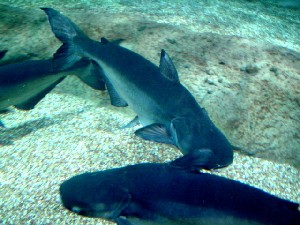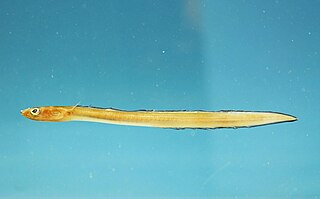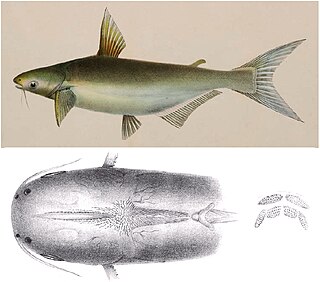
The iridescent shark or iridescent shark catfish is a species of shark catfish native to the rivers of Southeast Asia. Despite its name, it is not a shark. It is found in the Mekong basin as well as the Chao Phraya River, and is heavily cultivated for food there.

Basa, as it is commonly referred to, is a species of primarily freshwater-dwelling catfish in the shark-catfish family, Pangasiidae, native to the Mekong and Chao Phraya river basins of Mainland Southeast Asia. Economically, these fish are important as a regional food source, and are also prized on the international market. Outside of Asia, such as in North America or Australia, they are often referred to as "basa fish" or "swai" or by their specific name, "bocourti". In the United Kingdom, all species of Pangasius may, legally, be described as "river cobbler", "cobbler", "basa", "pangasius" or simply "panga", as well as any of these names with the addition of "catfish". In the rest of mainland Europe, these fish are mostly sold as "pangasius" or "panga". In Asian fish markets, names for basa also include "Pacific dory" and "patin". Other, related shark-catfish species may occasionally be labeled—albeit incorrectly—as basa, including the iridescent shark and the yellowtail catfish.

The shark catfishes form the family Pangasiidae. They are found in fresh and brackish waters across southern Asia, from Pakistan to Borneo. Among the 30-odd members of this family is the plant-eating, endangered Mekong giant catfish Pangasianodon gigas, one of the largest known freshwater fish. Several species are the basis of productive aquaculture industries in Vietnam's Mekong Delta.

Pangasianodon is a genus of large to very large shark catfishes native to the Mekong and Chao Phraya Rivers in Southeast Asia and adjacent China.

Catfish are easy to farm in warm climates, leading to inexpensive and safe food at local grocers. Catfish raised in inland tanks or channels are considered safe for the environment, since their waste and disease should be contained and not spread to the wild.

Leptobarbus is a genus of cyprinid fish that are native to freshwater habitats in Southeast Asia. They are important food fish. It is the only genus in the subfamily Leptobarbinae. Leptobarbus hoevenii or "sultan fish" migrate the fresh water rivers of Malaysia and travel at the surface in schools of 40-80 individuals at speeds of 0.48-1.08 km. Acid-soluble collagen (ASC) and pepsin-soluble collagen (PSC) were extracted from the muscles of selected cultured catfish, red tilapia, black tilapia, pangasius catfish, sultan fish and labyrinth fish, freshwater fishes that are widely consumed in Malaysia. The extracted yields for the tested species were higher for PSC as compared with ASC.

Pangasius pangasius, the Pangas catfish, is a species of shark catfish native to fresh and brackish waters of Bangladesh, India, Myanmar, and Pakistan. It has also been introduced to Cambodia and Vietnam. This species grows to a standard length of 3 metres (9.8 ft). This species of fish is eaten by the people of South Asia, the other being P. silasi from the Krishna River.

The giant pangasius, paroon shark, pangasid-catfish or Chao Phraya giant catfish is a species of freshwater fish in the shark catfish family (Pangasiidae) of order Siluriformes, found in the Chao Phraya and Mekong basins in Indochina. Its populations have declined drastically, mainly due to overfishing, and it is now considered Critically Endangered.
Dussumieria is the genus of rainbow sardines, a group within the round herring family Dussumieriidae. They are found in Indo-Pacific.

Ariosoma is a genus of marine congrid eels.
Panga is the common South African name for Pterogymnus laniarius, a small, ocean-dwelling fish.

Rhynchoconger is a genus of eels in the family Congridae.
Pseudolais is a genus of shark catfishes native to Southeast Asia.
Pangasius kinabatanganensis is a species of shark catfish. It is a freshwater, benthopelagic and tropical fish, measuring up to 23.8 centimetres (9 in) long. It is found in the Kinabatangan basin, in northeastern Borneo which is in the state of Sabah, Malaysia.
Pangasius conchophilus is a species of shark catfish. It is a freshwater, benthopelagic, potamodromous and tropical fish, measuring up to 120 centimetres (3.9 ft) long. It is found in the Mekong, Bangpakong, and Chao Phraya basins.
Pangasius myanmar is a species of shark catfish. It is a freshwater, benthopelagic, tropical fish, measuring up to 120 centimetres (3.9 ft) long. It is found from Irrawaddy to Salween and in Rangoon.
Pangasius humeralis is a species of fish in the family Pangasiidae. It is endemic to the Kapuas River basin of Borneo.

Pangasius djambal is a species of freshwater fish in the family Pangasiidae, commonly found in Southeast Asia.












